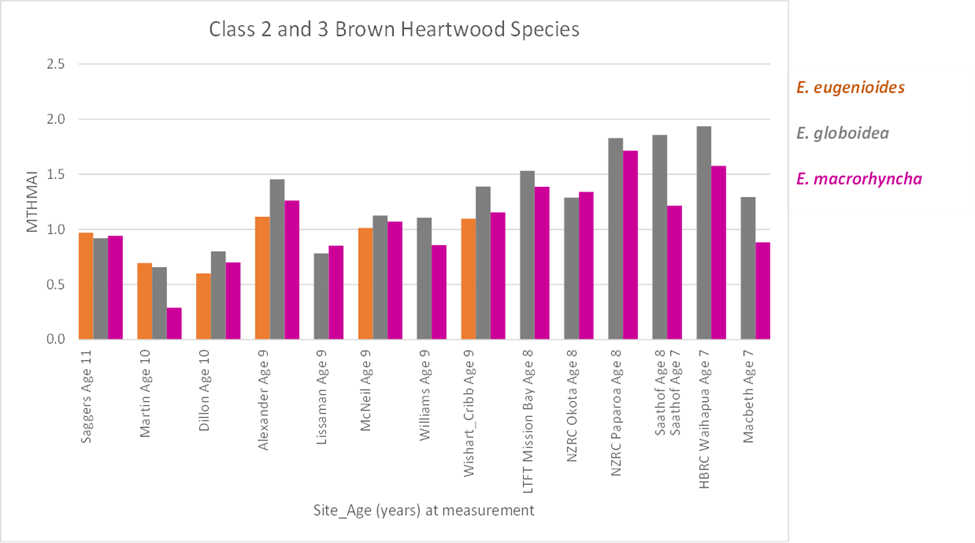Phone: 03 577 2395
C/- Marlborough Research Centre Trust, PO Box 875, Blenheim 7201


The three Class 2 and 3 brown heartwood species being evaluated in NZDFI's demonstration trials are:
Comparative growth of the three species

Class 2 and 3 brown heartwood species comprarative growth Mean Top Height Mean Annual Increment (MTHMAI) across all sites.
E. eugenioides - Thin-leaved stringybark
E. eugenioides produces class 2-3 timber, and was included in NZDFI's trials because of its potential suitability in North Island east coast environments.
It was only planted in the 2011 trial series; the analysis is based on measurements from 12 PSPs in six trial sites.
The most productive trials had a MTHMAI of 1.1m; in the least productive, the MTHMAI was 0.6m.
For more information see:
----------------------
E. globoidea - White stringybark
E. globoidea is a primary species in NZDFI's breeding programme (along with E. boisistoana). It is a class 2 species, expected to grow well on a range of site types.
Trial results show high variability in productivity between sites. At its best E. globiodea has the highest MTHMAI of any NZDFI species. At the two most productive trials for E. globiodea, both in Hawkes Bay, the MTHMAI was 1.9m. The average MTHMAI was 1.3m; the lowest MTHMAI was 0.8-0.9m, some 200% lower than the best performing trials.
Results show general good survival and early growth. It grows best on sheltered higher rainfall sites, but is intolerant of frost and waterlogging, with lower productivity on low rainfall sites.
E. globiodea appears relatively unaffected by insect pests.
For more information see:
-------------------------
E. macrorhyncha - Red stringybark
E. macrorhyncha was planted in all the 2011-2014 trials. It is a class 2-3 species and is thought to have good potential on dry, colder sites.
As with other species, there is a high degree of variability in its productivity between sites.
The most productive site (NZRC Paparoa) had a MTHMAI of 1.7m; the average MTHMAI is 1.1m; at the two least productive sites the MTHMAI is 0.7m and 0.3m respectively.
It has shown high survival and early growth across the NZDFI trial network and moderately productive growth in some of our drier, colder and exposed sites.
E. macrorhyncha is minimally affected by insect pests.
For more information see:
C/- Marlborough Research Centre Trust, PO Box 875, Blenheim 7201